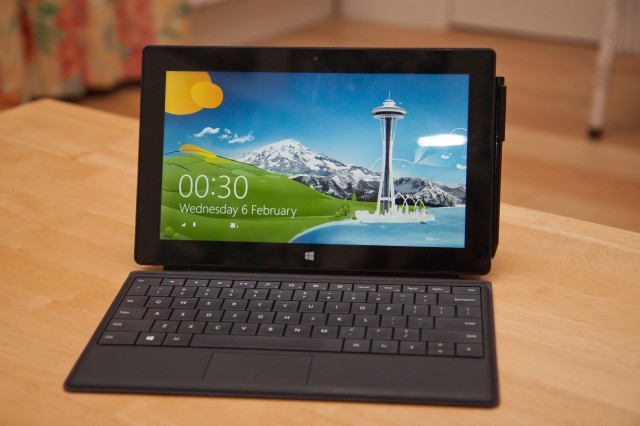
Microsoft's first ever computer, the Surface with Windows RT (or "Surface RT" as I will henceforth call it) is a mixed bag. The design and build quality both impress, and Microsoft's twin typing solutions—the 3mm no-moving-parts Touch Cover and the 6mm real keyboard-equipped Type Cover—are remarkably effective.
| Specs at a glance: Microsoft Surface with Windows Pro | |
|---|---|
| Screen | 1920×1080 10.6" (207 ppi), 400 nit, 10-point capacitive touchscreen |
| OS | Windows 8 Pro |
| CPU | Intel 3rd generation Core i5-3317U |
| RAM | 4GB (non-upgradeable) |
| GPU | Intel HD Graphics 4000 |
| HDD | 64GB or 128GB solid-state drive (of which about 25 or 89 GB are usable) |
| Networking | 802.11a/b/g/n with 2x2 MIMO antennas, Bluetooth 4.0 |
| Ports | Mini DisplayPort, headphones, microSDXC, USB 3.0, Cover port |
| Size | 10.82×6.77×0.52" (274×172×13.2 mm) |
| Weight | 1.99lb (0.903kg) |
| Battery | 42Wh |
| Warranty | 1 year |
| Starting price | $899 |
| Price as reviewed | $1128.99 |
| Sensor | Ambient light sensor, Accelerometer, Gyroscope, Magnetometer |
| Other perks | 48W charger with 5W USB port |
The screen resolution, however, is substantially lower than those of its comparably-priced competitors. The touchpads of those covers are wretched (in the Surface review, having used them for a week, I thought they were poor; with several months under my belt, I now think they're downright bad). The processor is underpowered.
But the biggest issue with Surface RT is its operating system: Windows RT. Windows RT can only (officially) run applications using the Metro user interface and the WinRT API. These were thin on the ground when I reviewed Surface RT, and they're thin on the ground today.
Surface with Windows 8 Pro (hereafter known as "Surface Pro") is Microsoft's second computer. It is a straightforward proposition: take Surface RT, give it an Intel processor, a high resolution screen, and stylus support. Next, make all the requisite changes to cope with the greater power consumption and heat output that the x86 processor implies—and all the software compatibility and performance that x86 brings.
Like Surface RT, but a little bit bigger
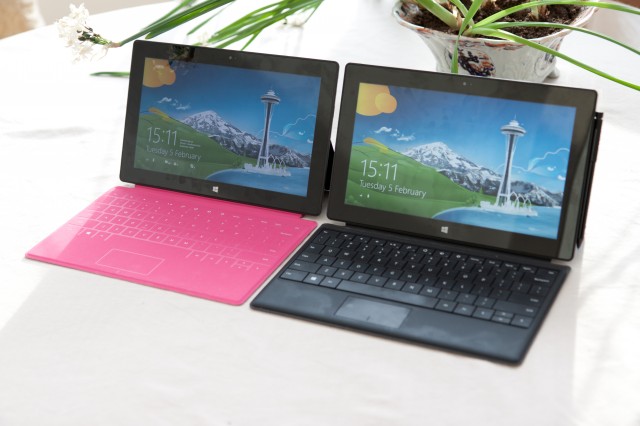
In isolation, the Surface Pro looks indistinguishable from its smaller sibling at first glance. It has the same black VaporMg finish that feels good in the hand and should resist everyday wear-and-tear with aplomb, and it has kept the trademark kickstand with its satisfyingly reassuring snap.
Put them side-by-side and the differences start to appear. The Pro is 4mm thicker, at 13.46mm compared to 9.3mm for the RT. It's 0.5lb heaver, coming in at a hair under 2lb. Its other dimensions are unchanged, with the screen retaining the 10.6 inch diagonal. This has been upgraded, however; it's now a Full HD 1920×1080 device, replacing the 1366×768 unit in the RT model.
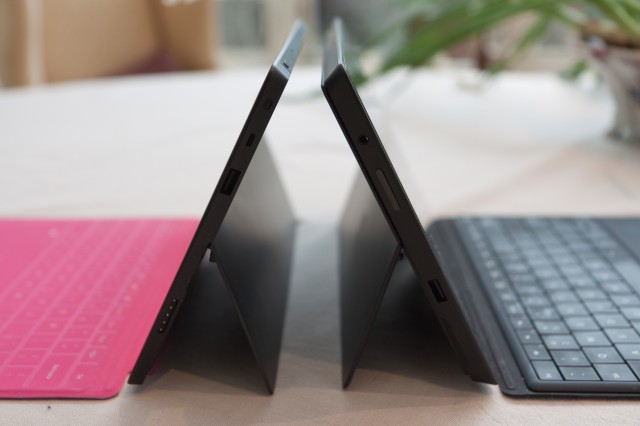
Closer inspection reveals the ports have been rejigged. The USB port moves from the machine's right side to its left, and although the port isn't the tell-tale blue (presumably to enhance the machine's aesthetics) it supports USB 3.0, compared to the ARM system's 2.0. The microSDXC slot, which in the Surface RT was positioned behind Surface's kickstand, is now more conveniently placed on the right hand side of the machine. It's easier to swap cards, but a little less clean-looking. Also on the right is a mini-DisplayPort, uh, port, replacing the micro-HDMI of the older unit.
The placement of the mini-DisplayPort is inferior. The microHDMI port on Surface RT is more or less where the microSDXC slot is on Surface Pro. This allows the power connector to be attached with the cable extending down, which means the little white LED at the top of the power connector, indicating whether a connection has been made, is visible.
On Surface Pro, if you use the power connector in that orientation it fouls the mini-DisplayPort connector. The power connector can connect in both orientations, so it's possible to use it "upside down," with the cable coming out the top. But then, the LED indicator is no longer visible.
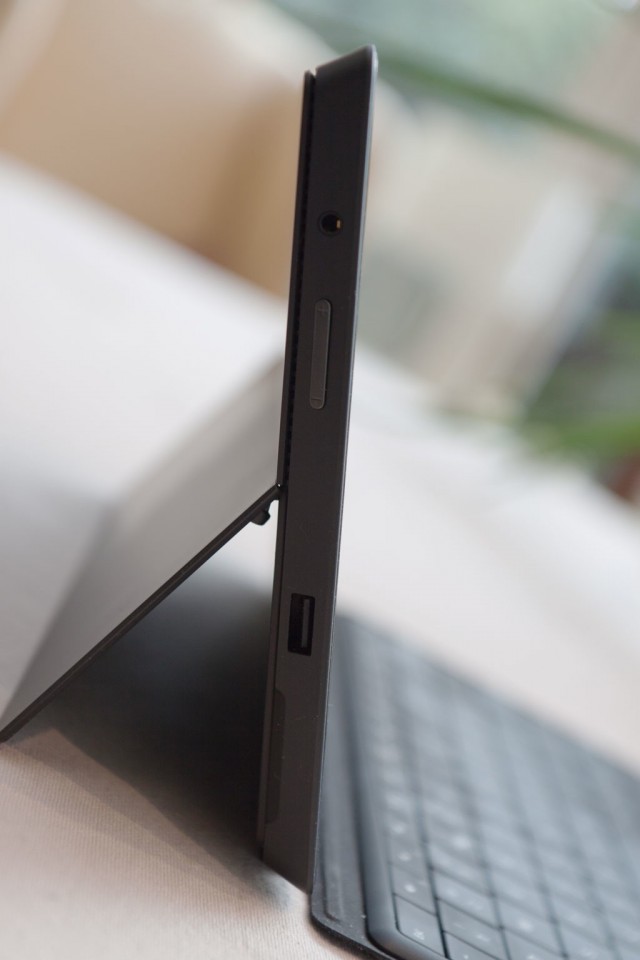
The placement of other buttons and devices is unchanged. The power button remains on the top right, with a volume rocker and headphone port on the left, a charging connector on the right, and 720p cameras front and rear. The Windows button is centered beneath the screen. And on the bottom there's the cover port, for connecting to the same selection of Touch and Type Covers as the ARM version supports.

The power connector retains the same magnetic connector, and this too is identical between the devices. Surface Pro's power adaptor is bigger, rated at 48W rather than 24W. It should in principle be able to fully charge the system in under an hour. The adaptor brick also sports a USB port, and can deliver up to 5W to a smartphone or other tablet to charge it.
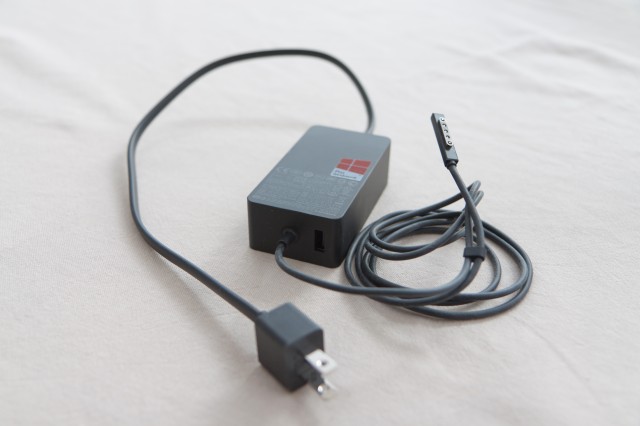
On Surface RT I had consistent issues with getting the power connector to marry properly. Sometimes it would appear to be magnetically latched, but it would actually be slightly skew and fail to charge the machine. The connector on Surface Pro hasn't had the same issue. It's still fiddly, but I no longer receive the false positives. Maybe it has been slightly tweaked to improve the connection; maybe I'm just more familiar with its foibles.

Surface Pro includes one other big feature not found in the RT: an active digitizer in its screen supporting a touch-sensitive pen. Wacom claims it's their technology being used, though there's no immediate indication in Windows of who made the digitizer. The pen has a barrel button and "eraser" tip, and it's pressure sensitive with 1,024 levels.
When not in use, it attaches magnetically to the charging port, with the barrel button serving dual purpose as the magnetic connector. On the one hand this is surprisingly secure; it should be safe to put the Surface Pro into a bag with its pen attached and not find the two are divorced when you get them out. This is fine when you're not charging the computer, but it means every time you plug into the wall you have to pull off the pen.
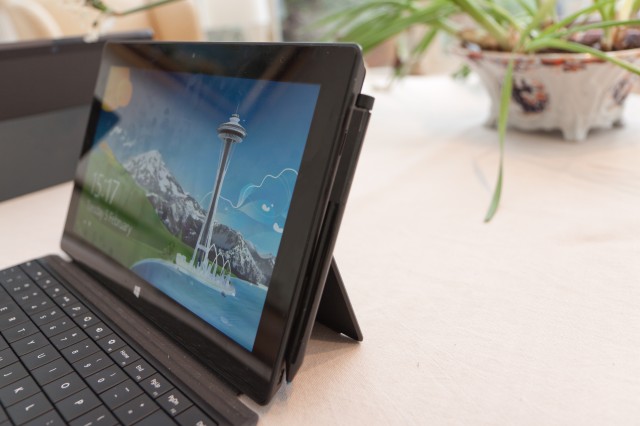
This is downright inelegant. It's going to result in unnecessarily lost pens. An integrated pen garage or holster is the better solution.
Ultimately, it makes me think the Surface Pro was something of an afterthought. Microsoft created the basic system design for the Surface RT, and since that has no active digitizer or pen, it doesn't need a place to store a pen. Rather than create a new design specific to Surface Pro's capabilities, Microsoft has performed a minimal modification of the Surface RT design. This precludes any major modifications such as adding slots for pens—and it's why we have the unfortunate mini-DisplayPort location too.
reader comments
366